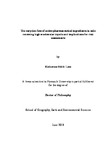The sorption fate of active pharmaceutical ingredients in soils receiving high wastewater inputs and implications for risk assessments
| dc.contributor.supervisor | Comber, Sean | |
| dc.contributor.author | Lees, Katherine Edith | |
| dc.contributor.other | School of Geography, Earth and Environmental Sciences | en_US |
| dc.date.accessioned | 2018-09-03T15:58:55Z | |
| dc.date.issued | 2018 | |
| dc.date.issued | 2018 | |
| dc.identifier | 10513387 | en_US |
| dc.identifier.uri | http://hdl.handle.net/10026.1/11977 | |
| dc.description | Chapter 1 has been published in the following paper. Lees, K., Fitzsimons, M., Snape, J., Tappin, A. and Comber, S., 2016. Pharmaceuticals in soils of lower income countries: physico-chemical fate and risks from wastewater irrigation. Environment International, 94:712-723. Chapter 3 has been published in the following paper. Lees, K., Fitzsimons, M., Snape, J., Tappin, A. and Comber, S., 2018. Does abiotic really mean abiotic? Assessing different soil sterilisation methods for use in OECD 106. Chemosphere, 209, 61-67. | en_US |
| dc.description.abstract |
Population growth, increasing affluence, and greater access to medicines have led to an increase in active pharmaceutical ingredients (APIs) entering sewerage networks. Wastewater in lower and lower middle-income countries use that use wastewater for irrigation may use untreated or poorly treated wastewater resulting in the potential for greater concentrations of APIs to enter soils in this way. Wastewater re-used for irrigation is currently not included in environmental risk assessments for APIs in soils. The addition of wastewater to soils changes the organic content and can increase the pH of soils, which will have an impact on the fate of any ionisable APIs introduced during the irrigation process. As the input of APIs to soil from wastewater irrigation is not currently included in the risk assessments, this is an area that requires increased attention. A study was undertaken using a modified sorption-desorption batch equilibrium method (OECD 106) to simulate the addition of synthetic wastewater (SWW) to soils compared to a normal OECD 106 study. The APIs studied were ofloxacin, propranolol, naproxen and nevirapine, and represent a range of API physico-chemical properties. These experiments showed that the changes to soil properties (pH and dissolved organic carbon (DOC)) caused by irrigation with SWW can change the fate of APIs in soils. The ionisation state of the API at the altered pH was more important for the positively charged propranolol than it was for the negatively charged naproxen and neutral nevirapine. The Kd and Log Koc increased during the sorption experiment in some cases with SWW. This has implications on the current terrestrial risk assessment where the trigger value for a more detailed soil risk assessment in at Log Koc >4. If the experiment is only performed in 10 mM CaCl2 as is currently required this may lead to unknown risks of APIs in wastewater irrigated soils not being taken into account. Three soil sterilisation or microbial enzyme suppression methods were investigated to identify how successful they were and if there was any impact on the soil physical chemical structure. Gamma irradiation, autoclaving and the addition of 0.2 g L-1 sodium azide were studied. None of the methods successfully sterilised the soils and some changes in soils were identified post-treatment. Autoclaving destroyed the soil structure, turning it into a fine powder and significantly increasing DOC. Sodium azide changed the pH of the loam soil but not the sandy loam soil. Literature suggested that gamma irradiation was the most likely to sterilise the soils with the least amount of disturbance to its physico-chemical properties but increases in DOC were identified in the current study. The changes to soils after sterilisation varied depending on the individual soil properties, indicating that soils should be studied on a case-by-case basis. Irrigation with wastewater provides continuous inputs of chemicals into soils throughout the growing season so it is vital that more work is done to understand the ultimate fate of pollutants in soil as a result. Wastewater has the potential to change the fate of chemicals in soils meaning that current risk assessments may not thoroughly assess all risks involved. | en_US |
| dc.description.sponsorship | AstraZeneca | en_US |
| dc.language.iso | en | |
| dc.publisher | University of Plymouth | |
| dc.rights | Attribution 3.0 United States | * |
| dc.rights.uri | http://creativecommons.org/licenses/by/3.0/us/ | * |
| dc.subject | Pharmaceuticals | en_US |
| dc.subject | Sorption | en_US |
| dc.subject | Soil | en_US |
| dc.subject | Terrestrial environmental risk assessment | en_US |
| dc.subject | Wastewater irrigation | en_US |
| dc.subject.classification | PhD | en_US |
| dc.title | The sorption fate of active pharmaceutical ingredients in soils receiving high wastewater inputs and implications for risk assessments | en_US |
| dc.type | Thesis | |
| plymouth.version | publishable | en_US |
| dc.identifier.doi | http://dx.doi.org/10.24382/426 | |
| dc.rights.embargodate | 03/03/2019 | |
| dc.rights.embargoperiod | 6 months | en_US |
| dc.type.qualification | Doctorate | en_US |
| rioxxterms.version | NA | |
| atmire.cua.enabled |
Files in this item
This item appears in the following Collection(s)
-
01 Research Theses Main Collection
Research Theses Main



